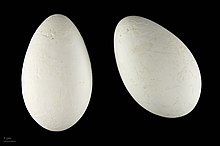Cuban flamingo
| Cuban flamingo | ||||||||||
|---|---|---|---|---|---|---|---|---|---|---|

Cuban flamingo |
||||||||||
| Systematics | ||||||||||
|
||||||||||
| Scientific name | ||||||||||
| Phoenicopterus ruber | ||||||||||
| Linnaeus , 1758 |
The Cuban flamingo ( Phoenicopterus ruber ) or red flamingo is a species of the flamingos (Phoenicopteridae). Its habitat are lagoons and salt lakes in Central and South America. Like all flamingos, the Cuban flamingo is serially monogamous, i. that is, it enters into a new relationship with each reproductive period. It is a colony breeder, its diet consists mainly of small crustaceans.
The IUCN states the total population of the Cuba Flamingo with 850,000 to 880,000 animals. The species is therefore considered "not endangered".
description
The plumage of flamingos Cuba is in breeding plumage uniform and stronger than that of the pink flamingos . The front half of the beak is black, the other half, closer to the base of the beak, is yellowish-pink. The legs are uniformly pink and flesh-colored. The weight is 2 to 2.5 kg for the females and 2.5 to 3 kg for the males, both parents hatch the young. The breeding period is 28 to 32 days and takes place between May and August.
The Cuban flamingo reaches sexual maturity at the age of 6 and has a life expectancy of over 40 years. The sexes of the animals can hardly be distinguished.
Distribution and existence
The Cuban flamingo breeds on the coasts of the Caribbean and the Galapagos . It was the first species of flamingo to be recorded for long foraging flights. A breeding colony of Cuban flamingos on Bonaire found their food mainly in the salt lagoons of this island. When these lagoons were cut off from the water supply in 1969, the food supply that was available locally to the flamingos changed drastically. Some of the flamingos breeding on Bonaire switched to other food sources. An increasing number of Cuban flamingos, however, made foraging flights into the coastal waters of Venezuela, which are 140 kilometers further south.
Like all species of flamingo, the Cuban flamingo breeds on conical mud hills. The flamingo sitting at the nesting site scrapes mud and other materials together with its beak and pushes this material towards its body. The egg is laid on the mud hill, which has a small hollow at the top. The mud mound protects the clutch from changing water levels, the small hollow prevents the egg from rolling off the cone. Cuban flamingos also use existing mud cones for their breeding. For Cuba flamingos it could be proven that individual mud cones were used by four different pairs of flamingos over a period of 18 months.
Cuban flamingos in the Zwillbrocker Venn
In the Zwillbrocker Venn in North Rhine-Westphalia on the border with the Netherlands , the Cuban flamingo first appeared in the local flamingo colony in 1994. Chile flamingos settled in the Zwillbrocker Venn in 1982 and greater flamingos in 1986 . The Chilean flamingos have been breeding successfully since 1983 and the greater flamingos since 1993. In 1993 there was a first unsuccessful mixed breed between Greater Flamingo x Cuba Flamingo, as there was only one single bird of the Cuba Flamingo in the colony. In 1994 a hybrid of a mixed breed Greater Flamingo x Cuba Flamingo fledged for the first time.
In autumn, the entire flamingo colony leaves the Fens. The flamingos, including the Cuban flamingo and the hybrid flamingos, visit resting areas such as the IJsselmeer , Veluwemeer and Oostvaardersplassen . The wintering area is the Volkerakmeer in the Rhine-Maas Delta . Initially, the young birds are still fed by their parents. Depending on the weather, the flamingos return to the Fens from late February to early March. In severe winters, however, they don't return to the area until the beginning of April. The subadults (birds that were hatched in the previous year) usually stay in the wintering area and only return to the colony as adults.
literature
- Bauer, H.-G .; Bezzel, E. & Fiedler, W .: The Compendium of Birds in Central Europe - Everything about biology, endangerment and protection. Volume 1: Nonpasseriformes - non-sparrow birds. 2. completely revised Ed., AULA-Verlag Wiebelsheim, 2005, ISBN 3-89104-647-2
- Josep del Hoyo et al .: Handbook of the Birds of the World. Volume 1: Ostrich to Ducks. Lynx Edicions, 1992, ISBN 8487334105 .
- Joop Treep, Dietmar Ikemeyer: Flamingos in the Zwillbrocker Venn . LÖBF reports 2006/3: 12–16.
Web links
- Phoenicopterus ruber in the endangered Red List species the IUCN 2008. Posted by: BirdLife International, 2008. Accessed January 30 of 2009.
- Videos, photos and sound recordings for Phoenicopterus ruber in the Internet Bird Collection
Single receipts
- ^ Alan Johnson and Frank Cézilly: The Greater Flamingo . T & AD Poyser, London 2007, ISBN 978-0-7136-6562-8 , p. 120
- ^ Alan Johnson and Frank Cézilly: The Greater Flamingo . T & AD Poyser, London 2007, ISBN 978-0-7136-6562-8 , p. 154



